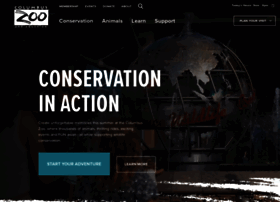
The Heart of Africa was designed with several project goals and interpretive outcomes in mind: to bring giraffe and zebra back to central Ohio to create fun, exceptional guest experiences that offer inspiring conservation success stories and that feature Jack Hanna as the virtual “tour guide” and to develop a region of the zoo that exceeds current standards and trends for animal care and management, and fiscal and environmental sustainability. In the distance, a hill with scrubby plants completes what appears to be an endless savanna, and screens views of the adjacent residential neighborhood and perimeter fence system. More than 40 trees have branches at up to 5.5 meters (18’) above the savanna floor to shade the giraffe while trees with lower branches, protected from the giraffe, shade smaller hoof stock. The landscape mimics the savanna grassland with pockets of trees scattered throughout the animal habitats and public area spaces. Around the corner, guests arrive at Jack Hanna’s campsite where they have an unobstructed view of the monkey exhibit.
.jpg)
Continuing, guests come across a watering hole in which animals are continually rotated throughout the day one may see ostrich in the morning only to return in the afternoon to see a cheetah run demonstration.įurther, a walk onto a raised deck allows guest to come face-to-face with giraffe and an opportunity to feed the herbivores. A seemingly stranded airplane offers close views of lions.

Graphic panels take on the look of a field guide of the savanna animals. Beyond the village, guests enter the theme area of Ajabu National Park, where they can enjoy more views of the 3.2 hectare (eight-acre) savanna and the animals that live there. From the village, guests can take in the grassland vista and gaze onto the savanna dotted with clusters of wildebeests, gazelle, ostrich, zebras and giraffes. The Mapori Restaurant serves local, freshly prepared and vegetarian food with some menu items featuring African cuisine. Once guests have entered Mudiwa Village, they find brightly painted kiosks which define a market area where Fair Trade products from Africa are offered for sale. Conservation messaging begins on this pathway as well – for example, a large wooden map of Africa highlights the countries and field projects that the zoo supports.

A camel ride is located on the opposite side of the path. A half-dozen bikes or so, laden with empty water jugs have been parked along fences, gates and walls that are covered with hand-painted murals. The pathway theming aims at building the anticipation of guests as they begin to explore. Entering the region through a hand-painted portico, guests begin their experience at the outskirts of Mudiwa – the replica of a lively, colorful African village, located at the edge of the savanna exhibits. The guest is transported with the sights and sounds of a busy village. Those that are listed here are kept in the enclosures specified in this description. The Heart of Africa is home to 155 animals and 25 species.

Your generosity creates experiences that bond families, inspires students, advances conservation around the world and sparks a lifelong appreciation for the animals we all love. When you give to the Zoo, you join a community passionate about connecting people and wildlife. Your support allows us to continue to fulfill the vision of Jack Hanna, who over three decades ago, began the Zoo’s transformation into the world-class facility it is today. Your gifts to the Zoo are more important than ever as we continue to “Lead and Inspire by Connecting People and Wildlife”. We are also very appreciative of our supporters who have included the Columbus Zoo and Aquarium in their estate plans. We are grateful to our annual donors who so generously support us. Make a Lasting Gift to Ensure the Future of the Zoo


 0 kommentar(er)
0 kommentar(er)
